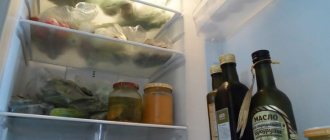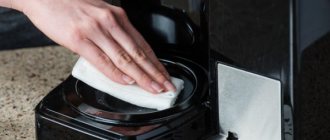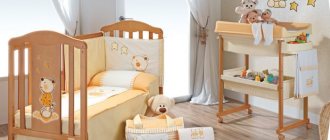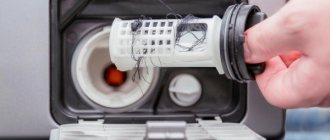The refrigerator is one of the most commonly used household appliances. Over time, various contaminants inevitably appear on its internal and external surfaces that must be removed.
Washing refrigerators equipped with a know frost system has a number of features that must be taken into account when performing the procedure.
How to clean the condenser on a refrigerator
- 4.1. How does the system work?
- 8.1. Related articles:
All it takes to keep your large unit running smoothly is a simple maintenance task that you can complete in less than 15 minutes. How cool is that!
The refrigerator is perhaps the most important major appliance in the kitchen, and it is often also the most expensive. Since you naturally want to maximize the performance of your refrigerator, why not extend its life and improve its efficiency by periodically cleaning your condenser coils?
Located at the base of the refrigerator or behind it, depending on the age and brand of the unit, these coils are filled with refrigerant that cools the air inside. The condenser coils are open rather than in a sealed casing and are therefore vulnerable to dust accumulation. A dirty condenser causes your refrigerator to work harder, keeping food cold, increasing energy costs and shortening the life of your expensive appliance.
Luckily, cleaning your refrigerator's condensers is an easy task for do-it-yourselfers. Be sure to clean your condenser at least once a year, or twice a year if you have pets that shed.
Keep reading to learn how to clean refrigerator coils and how to easily maintain your refrigerator.
Materials and tools needed to clean the refrigerator condenser:
- Dust mask
- Flashlight
- Vacuum cleaner with narrow hose attachment
- Condenser cleaning brush
STEP 1 Unplug the device (the first rule of any technical support, service or repair of the device). This may require you to remove the refrigerator from the wall if there is an outlet behind it. Don't worry about food spoilage: the coil cleaning process is quick (15 minutes or less) and the doors remain closed so your food stays cold.
STEP 2 Locate the condenser coils at the base of the refrigerator at the front, behind the hinged grille. If your refrigerator does not have a foot guard, you will find the capacitors located on the back of the refrigerator. The capacitor consists of metal tubes wound in the form of a U-shaped lattice. If your refrigerator's condenser is at the back, you will need to pull the refrigerator completely away from the wall to clean them.
STEP 3 Put on a respirator. (Most of the dust/debris will be removed by the vacuum cleaner, but some will undoubtedly become airborne.) Using a flashlight to help you see the condenser if it is located under the refrigerator, vacuum up loose dust and debris along the inside surface of the foot grate or from the back sides of the refrigerator.
STEP 4 Brush off dust with a coil condenser brush. This brush is approximately 70 cm long with short bristles on the top third, its cylindrical design allows it to move easily between gaps in the coil grid. Work it back and forth to remove dust, and try to gently twist it to get into corners and tight spots.
Keep the vacuum running while cleaning. If the cleaning coils are located on the back wall of the refrigerator, hold the narrow end of the attachment next to the brush with one hand and the brush with the other. If you clean the coils at the base of the refrigerator, it is easier to alternate between cleaning and then vacuuming up the dust.
STEP 5 Vacuum any foreign dust that may have landed on the floor. Replace the foot grill (it should click easily) and, if necessary, put the refrigerator in place. Plug your refrigerator's power cord back in and you're good to go!
Question to an Expert Where is the condenser on a refrigerator? Condenser coils are located on the back of the refrigerator or across the bottom. These tubes cool and condense the refrigerant. When the tubes are clogged with dirt and dust, they cannot evaporate heat effectively. How does a refrigerator condenser work? The compressor compresses the refrigerant vapor, increasing its pressure and temperature, and pushes it into the condenser coils on the outside of the refrigerator. When the hot gas in the condenser coils reaches an air temperature lower than the air in the kitchen, it becomes a liquid. Now in a liquid state at high pressure, the refrigerant cools as it passes through the expansion valve and into the evaporator coils inside the freezer and refrigerator. The refrigerant absorbs heat inside the refrigerator as it passes through the evaporator coils, cooling the air inside the refrigerator. Finally, the refrigerant evaporates to gas due to the increased temperature and then returns to the compressor where the cycle begins again.
Features of care
When transporting independently:
- Vertical position of the unit. The angle of inclination of the equipment is no more than 40 degrees;
- If the equipment is delivered lying down, then the compressor tube is at the top;
- Installation of the device - away from heating;
- Avoid direct sunlight;
- The minimum distance between the refrigerator compartment and the stove is 0.5 meters;
- The space next to the refrigerator compartment should be free within a radius of 50 mm;
Only if the operating conditions are observed, the proper level of air flow circulation is ensured and overheating of the compressor is avoided.
Note! If the floor in the room where the equipment is installed is planned to be insulated, then the place where the unit stands and the floor underneath it does not need to be insulated.
How to wash the back of a refrigerator
In the factory instructions of any refrigeration device there is a phrase that you should wash the back of the refrigerator 1-2 times a year. It's not just about the desire for cleanliness.
Regular cleaning of the refrigerator condenser and freeing the fan from a veil of caked dust are important elements for the durability of the entire installation.
Cleaning the condenser
The condenser is a complex system of thin tubes bent into a U-shape, soldered into a single black coil. The unit is designed to dissipate excess heat into the surrounding air. The main characteristic that is required of it is the ability to radiate as much heat as possible. Any contamination on the surfaces of the heat exchanger impairs the quality of operation, even completely stopping if the adhering dust is compressed into a felt “coat” and does not allow air to pass through.
To properly clean the rear of the refrigerator from dust, you need to unfold it, opening access to the back wall. You don’t have to worry about the safety of your food – all the work will take no more than 15-20 minutes, and the doors will remain closed. This applies to cases when only cleaning the refrigerator condenser without defrosting is carried out.
Depending on the model and year of manufacture, the evaporator will be located either directly on the wall or below near the compressor. Then you will need to remove the protective cover by unscrewing several screws. The lower location of the compressor suggests that there is a fan next to it, which forcibly creates an air flow, taking it through the cracks in the cover.
Sequence of work:
- Unplug the refrigerator from the electrical outlet.
- Clear access to the radiator grille of the cooler; if necessary, remove the enclosing panels of the case.
- Try to clean your refrigerator condenser using a vacuum cleaner with a narrow crevice attachment that gets into tight spaces.
- Use a brush with long, stiff bristles to remove any remaining dirt and grease that you couldn't pick up. It is convenient to work by holding the brush with one hand and bringing the vacuum cleaner hose to the treated area with the other.
- If you can't get all the dirt out with a brush in particularly tight, tight spots, use a wooden or plastic (not metal) ruler to get into the hard-to-reach areas.
- With old devices, a sticky coating may form on the surface of the heat exchange tubes due to the fact that the oil in the compressor leaks out under pressure through microcracks that appear and contaminates the parts. To clean the refrigerator condenser of old oil, use household dishwashing detergent. More aggressive chemicals that can harm radiator tubes should not be used.
- Before turning on the device, make sure that there are no residual moisture or detergents on the surfaces. If necessary, dry with a hairdryer or let dry on your own.
The main mistake that should not be made is damaging the fragile condenser tubes mechanically or with too caustic chemicals.
Washing the rear grille
In older models, the condenser appears as a black coil on the back wall of the refrigerator. It operates on the principle of free circulation: there is no forced blower, the air that has received heat rises naturally, making room for cool air.
To clean the back of the refrigerator grille on older models, use the same vacuum cleaner, but there are no electrical wires or contacts nearby. Therefore, after collecting dust, wash the tubes with a moderate amount of water and detergent. Do this carefully without damaging them. Some housewives use a kitchen bottle brush to clean the refrigerator grille. It's also convenient.
Cleaning the fan from dust
According to professional repairmen, a clogged blower fan in the engine compartment is one of the most common malfunctions that they encounter in their work. The reason is obvious: in almost all models the compressor compartment is located below, near the floor. The powerful air suction of the blades pulls all the dust and debris inside. The fan clogs especially quickly when there are cats or dogs in the house. The fur of a shedding pet will clog all the holes in the condenser and jam the rotation of the blades.
With the blower not working, the freon in the system tubes will not release excess heat, and the efficiency of the cycle will noticeably decrease. The compressor will stop turning off. It won’t be able to work like this for a long time; it will overheat, wear out and fail. Neglect of the owners to take basic care of their kitchen appliances will result in expensive repairs (the cost of replacing a compressor with labor is about a third of the cost of a new refrigerator).
Often it is enough to simply clean the dust from the refrigerator fan, Electrolux, Liebherr or another brand, to avoid the compressor motor burning out after a month or two. To clean, remove the protective cover of the compressor compartment, revealing access to the fan blades, and collect all unnecessary items with a vacuum cleaner. If necessary, use a stiff brush.
Do not use liquid detergents, since the compartment contains a lot of electrical wires, contacts and parts for which moisture or chemicals are harmful.
Rear wall wash
High-quality thorough cleaning with the removal of protective panels and maintenance of refrigeration units seems too complicated a procedure. There is not always enough time for it. But even if you simply clean the back wall of the refrigerator from dust, paying attention to the ventilation holes, you will be able to avoid future problems with a motor compartment fan clogged with hair.
When the condenser grille is hidden under a decorative sheet with slots for air passage, this panel must also be kept clean. To clean the back wall of the refrigerator, you can use any household appliance detergent that does not foam very much. Penetration of foam, as well as moisture, into the engine compartment can cause short-circuiting of the automation relay or corrosion of the electrical terminals.
HOW TO WASH YOUR FRIDGE PERFECTLY?! General cleaning of the refrigerator. We remove mold and dirt.
Watch this video on YouTube
Possible faults
No Frost system refrigerators have faults similar to conventional refrigerators, for example:
- If the device does not turn on, or turns on but does not make sounds or freeze, the compressor is faulty.
- If it does not respond at all to being turned on, or even the light does not come on when the door is opened, either the power cord or the control board is faulty.
- Ice formation or liquid leakage from somewhere indicates a faulty heater or an interrupted heating cycle.
- Sometimes malfunctions are associated with a loose door fit or incomplete pressing of the limit switch (usually located along the perimeter of the chambers at the end, so that the door presses on it when closing).
- Unclear operating mode: excessive freezing or vice versa - poor cooling can occur due to faulty temperature sensors, thermostats or problems with the compressor, and it cannot create normal pressure.
- If freon leaks, the refrigerator freezes poorly or does not freeze at all.
- The fan may not rotate due to frozen blades or if the motor is burned out.
- If the defrost timer is faulty, the heating element will work continuously.
On a note! In modern household appliances, control boards often fail.
Cleaning LG No Frost refrigerator without defrosting
Despite the fact that the Know Frost refrigerator assumes automatic defrosting, this procedure must be carried out manually at least once a year. A thorough cleaning includes high-quality cleaning of all sections, including the freezer.
If not much time has passed since the last defrosting, and the refrigerator needs cleaning, you can do without defrosting.
However, you will have to act quickly:
- the refrigerator is disconnected from the network;
- the freezer is left closed;
- quickly remove, wash and dry all shelves;
- remove dirt from the internal walls of the device;
- wash the outside of the refrigerator;
- carefully collect all the moisture - for this it is better to use paper towels;
- install components in place, put products on shelves.
How does the system work?
The difference between know frost units and devices with drip defrosting is the absence of a freezing evaporator in their freezer chamber.
The evaporator is a coil-shaped radiator made of aluminum and located behind the rear panel of the freezer.
ATTENTION! In the space between the outer and inner walls of the chamber there are air channels through which cold air is evenly distributed throughout the refrigerator.
There is a drainage hole at the bottom of the evaporator: through it, the moisture generated as a result of thawing of this functional unit goes into a special container near the compressor and evaporates.
The fan (located next to the evaporator) is a plastic impeller or wheel-shaped device that directs cooled air through a system of air ducts to various parts of the chambers.
The heater is a spiral (made of tungsten or nichrome) placed in an aluminum housing or glass flask. The purpose of the unit is to remove frost from the evaporator.
The operating principle of the know frost system:
- when the refrigerator is turned on, the compressor and fan start working, and the air gradually cools;
- When the temperature on the thermostat reaches 10 ⁰С below zero, the timer breaks the “fan-compressor” circuit and closes the “heater-evaporator” circuit, as a result of which the evaporator heats up and the frost melts. Defrosting occurs until the thermostat reaches a temperature of 10 ⁰C. After this, the timer closes the circuit between the fan and compressor again;
- 8 hours after the first defrost, the timer repeats the evaporator defrost cycle again.
Cooling of the chambers occurs as follows:
- warm air from the interior of the refrigerator absorbs the refrigerant passing through the evaporator;
- the substance boils under the influence of elevated temperature and goes into a gaseous state;
- the compressor pumps freon into the condenser, where its temperature drops again and it turns into liquid, which enters the capillary tubes located between the inner and outer walls of the chamber;
- cooled freon again “takes” heat from the refrigerator compartments, turns into steam and enters the evaporator. The cycle repeats.
HOW TO WASH YOUR FRIDGE WITH SODA in 7 steps?? #irinasokov
Watch this video on YouTube
Does it need to be defrosted?
The know frost system provides for automatic defrosting of the device. However, many owners of household appliances during their operation are faced with the fact that frost forms in the freezer and sometimes even inside the refrigerator compartment.
Why does this happen? The reason for the formation of ice is non-compliance with the rules for using the refrigerator: overloading the shelves with many pots, bowls of food, placing hot food in it.
ATTENTION! The appearance of a snow “coat” may be associated with a malfunction of the device: failure of the thermostat, damage to the rubber seal on the door, clogging of the capillary tubes.
In addition, the operation of the know-frost system is directly affected by the choice of the correct operating mode of the refrigerator: too low a cooling temperature for the chambers or a constantly turned on super-freezing function leads to freezing of the chambers.
Taking into account the listed factors, it should be said that even such modern devices also require manual defrosting. The frequency of defrosting directly depends on the rate of ice formation; in most cases, the device must be defrosted and washed at least once a year.
If frost is not removed, the heat exchange between the chamber walls and the refrigerant will be disrupted. As a result, the compressor will have to work with more power, which can lead to rapid wear of the functional element and breakdown of the refrigerator.
IMPORTANT! One of the main factors indicating the need for urgent defrosting of the device is the thickness of the formed ice: if the layer of frost on the walls approaches 1 cm, start defrosting.
Where to start cleaning?
Start cleaning the refrigerator only after it has defrosted:
- set the thermostat to position “0”, disconnect the device from the network;
- lay old towels on the floor around the refrigerator, open the door of the device and fix it in this form;
- remove food from the refrigerator and place it in a cool place;
- remove all removable elements (shelves, drawers), wash them in soapy water, rinse and leave to dry;
- remove the moisture formed during the defrosting process and begin washing the device.
IMPORTANT! If both refrigerator compartments are equipped with a know-frost system, you can defrost and wash them either simultaneously or alternately.
What cleaning products can be used?
To wash your refrigerator, you can use both chemicals and homemade products.
Dish detergent:
- pour hot water into a bowl, add a couple of teaspoons of washing gel to it, mix the ingredients until foam forms;
- soak a soft sponge in the solution, wipe all elements previously removed from the device (shelves, grilles, drawers) and the internal and external surfaces of the refrigerator;
- After removing dirt, be sure to rinse off any remaining cleaning product with water.
Other chemicals in the form of various sprays, liquids, foam, wet wipes (Top House, Silit Bang, Horse) are also suitable for cleaning the refrigerator.
In addition to excellent cleaning properties, which allow housewives to get rid of contaminants in the device in a short time, most of these products also have disinfecting abilities.
IMPORTANT! When working with special preparations, do not forget to wear rubber gloves. After cleaning surfaces, be sure to wipe them with a cloth dampened in clean water.
Traditional methods will also help you rid your refrigerator of stains of various origins:
- make a soda solution from 2 tablespoons of powder and 1 liter of water, treat the inner walls of the chambers with it, rinse the surfaces with water;
- grate half a bar of laundry soap, mix the shavings with warm water. Use the product to remove dirt from problem areas;
- dampen the sponge in hydrogen peroxide (3%) and wash the chambers.
The sealing tape on the door of the device can also be cleaned with dishwashing detergent and hydrogen peroxide.
The use of vinegar, soda to remove mold or grease from a rubber element is unacceptable, since these substances can damage the part and break the seal of the chambers.
If you notice that the tape has lost its elasticity, apply a little olive oil to a rag and rub it into the seal.
IMPORTANT! To clean the refrigerator, do not use aggressive chemicals (containing chlorine, concentrated acids, alkalis) or abrasives. Treat the surfaces of electrical appliances only with soft cloths or sponges.
Household chemicals
You can clean the Know Frost refrigerator using specialized household chemicals, which are introduced specifically for these purposes. Such products are sold in retail stores, as well as in online markets.
In addition, refrigerator manufacturers are developing formulations designed specifically for their brands. They claim that such chemistry is safe and most effective. However, branded liquids are expensive and are rarely found on the open market.
Gel Clean Home
A universal composition that is gentle on various surfaces. Advantages:
- Available in liquid form,
- easy to apply on a sponge,
- has a pleasant smell,
- Effectively removes even stubborn stains.
The product contains hydrogen peroxide and active oxygen ions. Bottle volume – 200 ml. Price – 93 rubles.
Sano Refrigerator Cleaner Spray
Liquid with a pleasant smell, suitable for cleaning interior and exterior surfaces. A convenient sprayer allows you to economically dose the composition. Package volume – 750 ml. Price – 460 rubles.
Luxus Professional
Spray with a pleasant mint aroma. It can be used to care for know frost refrigerators, as well as freezers.
The composition not only perfectly cleans all surfaces, but also eliminates unpleasant odors. Volume – 500 ml. Price – 154 rubles.
Where to start cleaning?
Start cleaning the refrigerator only after it has defrosted:
- set the thermostat to position “0”, disconnect the device from the network;
- lay old towels on the floor around the refrigerator, open the door of the device and fix it in this form;
- remove food from the refrigerator and place it in a cool place;
- remove all removable elements (shelves, drawers), wash them in soapy water, rinse and leave to dry;
- remove the moisture formed during the defrosting process and begin washing the device.
IMPORTANT! If both refrigerator compartments are equipped with a know-frost system, you can defrost and wash them either simultaneously or alternately.
Find out more about defrosting a two-compartment Bosch refrigerator. Read about how to defrost a Stinol two-chamber refrigerator here.
How to properly clean up the interior?
- When cleaning a household appliance, start by cleaning its internal parts, moving from top to bottom and paying special attention to the corners of the chambers;
- do not forget to wash and disinfect the drain hole on the back wall of the refrigerator compartment: clean it with a brush, then draw detergent into a syringe (without a needle) and pour it into the channel;
- clean the holes on the fan grille with cotton swabs soaked in cleaning product;
- wash the outer parts of the case, wipe the condenser located on the back wall with a slightly damp sponge;
- Wash the sponge or rag from any remaining cleaning products, fill a bowl with water and rinse all surfaces with it;
- take a dry towel and wipe the refrigerator inside and out;
- leave the device with the door open so that all moisture from the internal surfaces completely evaporates;
- Reinstall the shelves and drawers in their original place, plug in the device and after half an hour place the food in it.
IMPORTANT! According to the recommendations of manufacturers of refrigerators with a no-frost system, such units can only be connected to the network 12 hours after being turned off.
Preparing for cleaning at home
Before you start cleaning the No frost refrigerator, you need to prepare it. This process includes the following steps:
The temperature regulator in the device is set to zero;- a rag is placed next to the door;
- disconnect equipment from the power supply;
- remove all food from the refrigerator;
- remove shelves, drawers, pallets, grates - all elements that can be detached are best washed separately;
- leave the freezer open and wait for the ice to disappear;
- accumulated water is collected with a sponge.
To assess the thickness of the ice layer, you can remove the back wall of the freezer. If it is thick, this indicates either improper operation of the device or a malfunction in its operation.
How to get rid of unpleasant odors?
The appearance of unpleasant odors in the device is most often associated with improper storage of products (failure to comply with product rules, storage of spoiled food, etc.).
To get rid of the “aroma,” first of all, find out and eliminate the cause of its occurrence.
The following methods will help eliminate strong odors from the refrigerator:
- mix vinegar and water in equal proportions and wash the inner walls of the chamber;
- crush 20-30 tablets of activated carbon, pour it onto plates or into gauze bags, place the product inside the refrigerator;
- crushed citrus peels (lemon, orange), black tea, sugar, rice, vanilla, coffee beans (grind them first) “absorb” various aromas well: as in previous cases, place the products in bags made of linen fabric, gauze, put inside a household devices.
Special balls for refrigerators, which are sold in household chemical stores, effectively eliminate even the most pungent odor.
The mineral components they contain destroy the unpleasant “amber” and prevent the appearance of mold. The balls are effective for 3-4 months; after this period, the drugs should be replaced with new ones.
ADVICE! Don't forget to take care of the device if you need to leave for a long time: defrost, wash the device and leave it unplugged, with the door open.
Carry out periodic checks of the products in the unit, throw away food that has expired, store food in special containers closed with a lid.
Cleanliness in the refrigerator is not only the key to your health, but also to the long life of your kitchen appliances.
What formulations can be used?
To clean the refrigerator, you can use both available detergents and specialized household chemicals. The most important rule is that the chosen composition must be liquid.
Under no circumstances should the following methods be used:
- Powders. Hard particles will leave scratches on the surface of the device, which in the future will become a source of unpleasant odor. Moisture accumulates in such microcracks, becoming an ideal place for microbes to multiply.
- Caustic compounds. They can damage the surface of the device and seals.
- Products with a strong odor or substances that are toxic to the body. Such compositions are prohibited for use on surfaces in contact with food.
To treat surfaces, you can safely use soda, vinegar, hydrogen peroxide, liquid dishwashing detergent, and soap. A solution is prepared from the listed substances, which is used to treat the refrigerator and all elements.
Another option is to use store-bought products designed to care for household appliances.
Refrigerator cleaning products should not include:
- chlorine,
- alkalis,
- highly concentrated acids,
- acetone or solvents.
To remove dirt, use only soft cloths or sponges.
How often should you clean your No Frost refrigerator?
Equipment manufacturers advise disconnecting it from the voltage and giving it a rest at least once a year.
If you notice that the device has begun to cool poorly or is malfunctioning, then it is better not to wait for a specific time, but to defrost it immediately. Therefore, answering the question: “How often should you defrost a No Frost refrigerator,” we can say: as soon as such a need arises. If you see that a thick layer of ice has formed on the walls of the equipment, this indicates that defrosting is necessary on the same day.
Tips for preventing ice from forming in the refrigerator
- To slow ice formation, wipe the inside of the walls with a mixture of water and glycerin. Dissolve them 1 to 1. An alternative option to prevent ice formation is to wet the walls with vegetable oil.
- Try not to leave the refrigerator door on for a long time so that warm air from the room does not affect the appearance of condensation.
- Wipe away accumulated water at the bottom of the refrigerator to prevent it from turning into ice.
Simple preventive measures will help you avoid icing. Do not neglect timely defrosting if you want your household appliances to last longer than their service life according to the passport.
What not to do and why?
Rules that must not be broken:
It is not recommended to use vinegar to wash the seal. A highly concentrated solution is especially dangerous. It can cause the rubber to lose its elasticity.- If you do not plan to defrost the refrigerator, then you should not open the freezer while cleaning.
- Do not attempt to scrape off dried food debris with a knife, blade or other sharp instrument.
- Before any washing of the refrigerator (with or without defrosting), it must be disconnected from the power supply to avoid electric shock.
- Before placing the glass shelf under running hot water, you need to wait until it warms up. Otherwise the part may burst. Boiling water should not be used.
Sources
- https://www.miodimore.ru/kak-ochistit-kondensator-u-holodilnika/
- https://techforhome.ru/chistka-kondensatora-holodilnika
- https://kuhniug.ru/bytovaya-tehnika/chistka-holodilnika-nou-frost.html
- https://yborka.online/tehnika/holodilnik/kak-myt/no-frost
- https://domibit.ru/byt/uhod/kak-myt-holodilnik-nou-frost/
Do you want to understand better than others?
- How long can fish be stored in the freezer and refrigerator - When buying fish, we want to be sure of its quality, because good ingredients are the basis of a tasty and healthy dish. The second important point in cooking is the correct…
- What you need to know about the Low Frost system - When buying a modern refrigerator, many do not understand what the term Low Frost means, indicated in the characteristics of the freezer. This type of defrosting technology was...
- Built-in refrigerators from the manufacturer AEG with No Frost: characteristics of the models - German appliances for any purpose, including household ones, are highly valued all over the world. High-tech refrigeration equipment is the main principle of the AEG brand, which was...
- Top 3 best two-chamber Pozis refrigerators with No Frost system: detailed review - No Frost is a system designed to prevent the formation of ice and frost. Full no frost implies that this type of work applies to both refrigeration and…
- LG No Frost refrigerator with bottom freezer: 20 photos + instructions - Refrigerator LG GA-B509CEWL / GA-B459CEWL / GA-B509MMQZ / GA-B509MESL / GA-B459MMDZ / GA-B459MMQZ / GA-B459MESL / GA-B509CEQZ / GA- B509CESL / GA-B509CECL / GA-B459CESL /…
Operating principle of drip defrosting
In refrigerators with drip defrost, the evaporator is located on the back side of the back wall of the chamber. Therefore, it is colder than other surfaces and, in accordance with the laws of physics, moisture contained in the air condenses on it. During operation of the compressor, it forms ice, which, after stopping, begins to melt and flows drop by drop into the outer container. Simplicity and the absence of additional devices make this system very reliable. The main disadvantage is the inability to work in the freezer.











